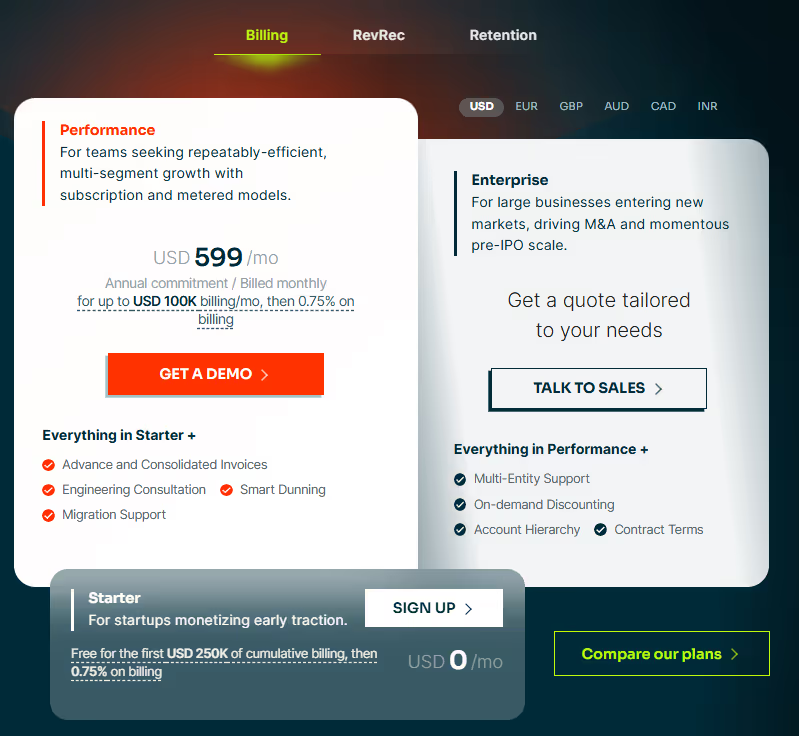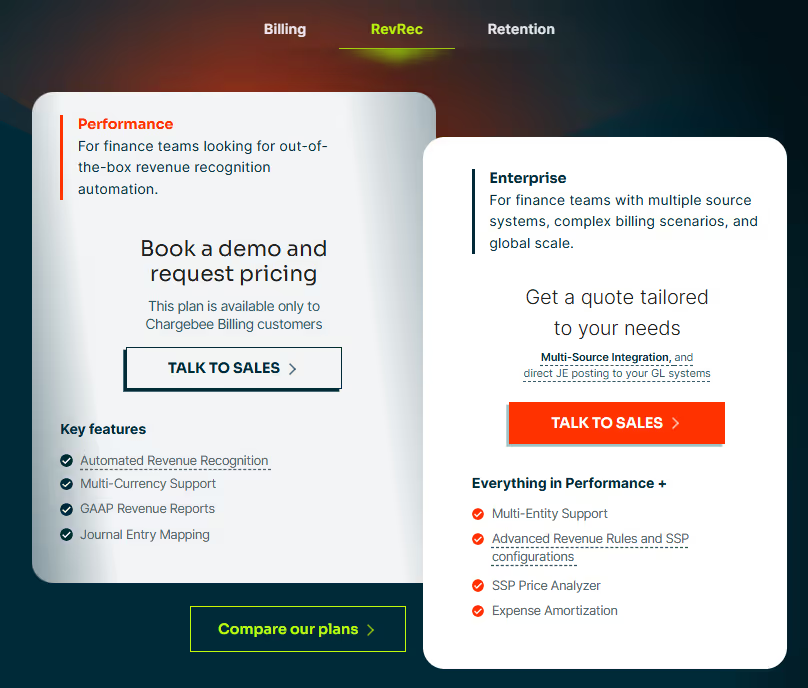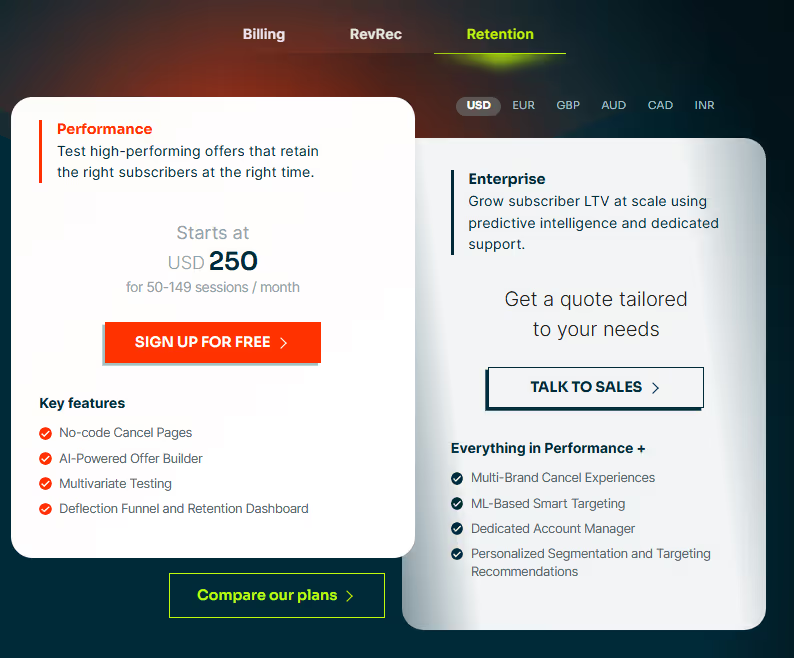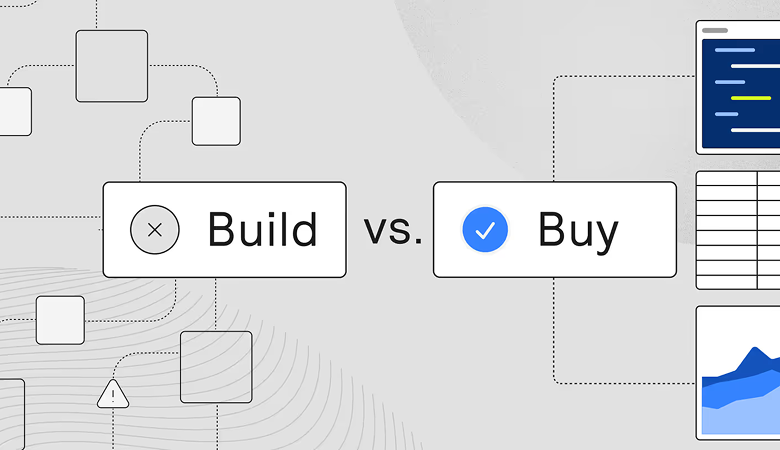Chargebee is a subscription billing platform built for SaaS companies, online marketplaces, and consumer brands that rely on recurring revenue. It helps firms go beyond basic payment tools by offering built-in support for subscription management, billing, and revenue recognition.
In the next sections, we’ll break down how Chargebee pricing plans really work, what each one includes, and how it compares to alternatives like Orb.
Chargebee’s current pricing plans (2025)
Chargebee pricing in 2025 is structured across three product lines: Billing, revenue recognition (RevRec), and retention. Each has its own tiers, thresholds, and upgrade paths. Let’s zoom in on each product line:
Chargebee billing plans

The image shows Chargebee’s three billing plans: Starter (free up to $250K in billing), Performance ($599/month for up to $100K MRR with 0.75% overage), and Enterprise (custom pricing with multi-entity support, account hierarchy, and custom contracts).
Starter plan
Chargebee’s Starter plan is free for businesses processing up to $250,000 in lifetime billing. It gives startups access to basic subscription billing tools like recurring invoicing, hosted checkout pages, and coupon management.
Once you cross that $250K threshold, a 0.75% overage fee applies to all additional billing, and certain operational limits, like 50,000 API calls per month, can slow your growth.
Tax automation isn’t included either, which may require workarounds for global sales. This plan is useful when you're validating product-market fit, but most companies outgrow it quickly.
Performance plan - $599/month (annual commitment)
The Performance plan is Chargebee’s entry point for scaling SaaS and subscription businesses. It supports up to $100,000 in monthly recurring revenue, with a 0.75% overage fee beyond that.
At this level, you gain access to consolidated invoicing, smart dunning workflows, custom domain support, and multiple payment gateway integrations. You also get engineering consultation and migration support, which aren’t available on the Starter plan.
However, automated revenue recognition, multi-entity support, and some advanced integrations still remain locked behind Enterprise. Annual contracts are required, and plan downgrades carry a 90-day notice period.
Enterprise plan - custom pricing
Chargebee’s Enterprise plan is meant for businesses with multi-brand operations, high billing volume, or complex pricing models. Features here include custom API rate limits, account hierarchies, on-demand discounting, multi-entity management, and support for tailored contract terms.
This tier requires custom implementation with hands-on support, and may involve custom dev work billed separately. You’ll also unlock deeper analytics, priority SLAs, and dedicated customer success teams, but expect significant costs as you scale.
Chargebee revenue (RevRec) plans

The image highlights Chargebee’s RevRec Performance plan with features like automated revenue recognition and GAAP reporting (available to Billing users only), and the Enterprise plan offering multi-source integration and advanced SSP configurations.
Performance RevRec
Chargebee’s Revenue Recognition module automates ASC 606 and IFRS 15 compliance, supports multi-currency transactions, and GAAP revenue reports. It also automates key workflows like contract modifications and deferred revenue management.
It's best suited for mid-market companies that need reliable compliance automation without investing in a dedicated rev rec engineering team.
Enterprise RevRec
This plan is for companies with highly tailored accounting needs. The Enterprise RevRec option offers custom revenue waterfall configurations, multi-GAAP support, audit trails, and commission amortization tools.
Pricing varies by volume and integration requirements. Do keep in mind that implementation often takes several weeks and often requires coordination with finance and engineering.
Chargebee retention plans

The image outlines Chargebee Retention’s Performance plan starting at $250/month for 50–149 sessions with tools like AI offer builder and cancel page testing, plus an Enterprise tier with predictive ML targeting and custom segmentation.
Performance plan - Starts at $250/month
The Performance plan is built for companies that want to test and launch targeted cancel flows using an intuitive, no-code interface. Pricing begins at $250/month for accounts running 50 to 149 Retention Workflow Sessions per month. You can sign up directly without going through sales.
This plan includes:
- No-code cancel pages that can be launched quickly without engineering help
- An AI-powered offer builder that recommends incentives to retain users
- Multivariate testing to compare offer effectiveness across segments
- A full deflection funnel and retention dashboard for monitoring and iterating campaigns
Performance is best for growth-stage teams ready to apply data-driven experimentation to reduce churn. As session volume increases, pricing scales with your usage.
Enterprise plan - custom pricing
The Enterprise Plan is designed for large teams managing high-volume retention workflows across brands or geographies. Chargebee tailors pricing based on your needs, so you'll need to speak with Chargebee's sales team. It includes everything in the Performance plan, plus:
- Multi-brand cancel experiences for organizations managing several product lines
- Machine learning-based smart targeting to automate retention offers based on behavior
- A dedicated account manager for strategic planning and hands-on support
- Personalized segmentation and targeting recommendations powered by predictive analytics
Enterprise is a fit for companies that treat churn prevention as a core part of customer lifecycle management and want the ability to scale those efforts with intelligence and precision.
Core differences between Chargebee plans
Does Chargebee have hidden fees, overage costs, or revenue limits?
Chargebee pricing models may look clean on the surface, but once you factor in overages, usage caps, and upgrade triggers, the total cost can rise fast, especially for growing SaaS teams. Let’s break it down:
Overage charges
Chargebee charges overages in nearly every product line:
- In Billing, the Starter plan includes up to $250K in lifetime billing. After that, you pay a 0.75% fee on all revenue beyond the cap.
- In the Performance billing plan ($599/month), the ceiling jumps to $100K in monthly recurring revenue (MRR), but the same 0.75% overage applies beyond that. For example, if you're processing $120K/month, you're on the hook for $150 in overages, bringing your monthly total to $749.
- In Retention, the Performance tier starts at $250/month for 50–149 canceled sessions. If you exceed your plan’s session limit, you’ll pay extra per session, at an unlisted but usage-scaled rate.
Keep in mind that these charges often aren’t visible until you exceed the plan limits. If your team grows or launches new products mid-year, expect your costs to spike.
Note: These cost structures reveal how Chargebee fees can scale unpredictably for companies using usage-based pricing models to chase revenue efficiency.
Who is Chargebee best for?
The right fit depends on how your team bills customers, what kind of support you need, and how much you’re willing to pay as you scale. Let’s break down where Chargebee pricing aligns with value, and where it starts to fall short:
Good fit
Chargebee works best for teams that:
- Run standard monthly or annual subscription billing
- Have predictable MRR and don’t rely on usage-based pricing
- Want a fast setup with out-of-the-box workflows
- Are processing less than $500K/year and can stay on the free Starter plan for a while
- Need solid invoice automation and mid-tier analytics without building custom tools
- Prefer a platform with ready-made integrations for Stripe, Recurly, and major CRMs
- Have limited engineering resources and don’t want to manage billing logic in-house
Not a good fit
Chargebee may not be the right choice for companies that:
- Use usage-based or hybrid pricing models
- Need real-time billing updates tied to customer activity
- Want to experiment with pricing without waiting on sales or contracts
- Expect predictable pricing without per-transaction or revenue-based overages
- Require deep rev rec automation as part of their core plan
- Rely on multi-entity management or consolidated reporting out of the gate
- Can’t commit to long-term contracts or want freedom to downgrade quickly
Note: Want to hear what real users say? Check out our Chargebee reviews article for genuine insights and feedback from teams using the platform across industries.
Chargebee vs. Orb: Pricing, flexibility, and scale
Chargebee and Orb both serve the subscription billing SaaS space, but they’re designed for different growth stages and technical needs. Let’s take a closer look at how they compare in core areas that affect cost, speed, and long-term value:
Orb is built for fast-growing SaaS and GenAI teams that need billing to move at the speed of product. With native usage-based billing, instant pricing changes, and a RevGraph architecture that decouples usage data from pricing logic, Orb helps teams adapt pricing models without waiting for custom code or contract changes.
Note: For a broader look at which platform fits your business goals, check out our guide to the top Chargebee alternatives. It covers tools built for modern subscription billing SaaS needs, from early-stage startups to high-volume platforms.
Final thoughts: Is Chargebee worth the price?
If you're a startup looking for a fast way to launch subscriptions, Chargebee can be a reasonable starting point. The Starter plan covers basic billing, and the interface is easy to understand. But as your product evolves, the pricing model starts to strain.
Chargebee pricing gets expensive quickly. Once you cross into the Performance tier, you're locked into annual contracts and exposed to 0.75% overage fees.
Add-ons like revenue recognition, tax automation, and advanced reporting are gated behind high-tier upgrades. For growing SaaS teams, that means more surprise costs, more conversations with sales, and more workarounds to fit your pricing into their structure.
The billing logic also lives inside their system templates, which means testing a new pricing strategy or customizing metrics often involves engineering, sales coordination, or both. If your revenue model is evolving (or you’re building for scale), that rigidity creates friction.
Why should you choose Orb over Chargebee?
Orb was built for companies that don’t want billing to hold them back. Whether you're pricing by API calls, tiered usage, or rolling credits, Orb gives you full control over how you monetize. Here’s how Orb compares for fast-growing SaaS teams:
- Model pricing with real product data: Orb Simulations lets you test pricing strategies before going live. You can model expected revenue impact and customer adoption using actual usage data tracking, no spreadsheets or guesswork required.
- Launch fast, without rewriting your billing logic: Orb separates billing from your product code, so you can make pricing changes without touching production. Business teams can roll out updates independently.
- Track usage at a granular level: Every event is captured, logged, and ready for billing. Whether you're metering messages, storage, or seats, you’ll bill customers for exactly what they use.
- Keep invoices accurate, auditable, and transparent: Customers see exactly what they’re paying for. Finance and RevOps teams get a single source of truth that syncs cleanly with reporting and compliance workflows.
- Adapt pricing without starting from scratch: With tools like plan versioning and pricing experiments, you can evolve your pricing model in days, not quarters.
If you want to launch pricing models like Wix, OpenAI, or Calendly, Orb helps you do it without complex engineering. You get the control and precision you need, with none of the rigidity that slows teams down.
Instead of working around your billing tool, make billing part of your growth engine. Ready to move faster? Explore Orb’s flexible pricing tiers and see how it adapts as your business scales.
FAQs
How much does Chargebee cost per month?
Chargebee starts at $0 for up to $250K in lifetime billing. Higher tiers and add-ons like revenue recognition or retention tools require custom pricing. Overage fees apply once you exceed plan thresholds.
What happens if I exceed the revenue cap?
Chargebee charges a 0.75% overage fee on any billing above your plan’s revenue limit. This applies to both the free and Performance tiers. Costs can scale quickly as your revenue grows.
Is Chargebee free to use?
Yes, Chargebee offers a free Starter plan for businesses processing under $250K in total billing. Once you exceed that cap, you’ll either pay overages or upgrade to a paid plan. Some features remain locked even at paid tiers.
Does Chargebee take a percentage of revenue?
Chargebee doesn’t take a cut by default, but it charges a 0.75% fee on revenue beyond plan thresholds. This fee applies in both the free and Performance plans. Enterprise customers may also face additional revenue share depending on contract terms.
How does Chargebee compare to Orb?
Chargebee is built around templates and fixed thresholds. Orb supports real-time usage tracking, pricing experiments, and flexible billing logic without overage penalties. Orb is better suited for SaaS teams with usage-based models or evolving monetization needs. It also offers faster implementation and more pricing control out of the box.

.avif)

